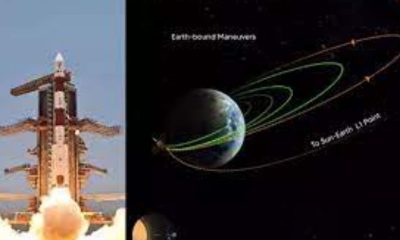Latest Science News
ISRO’s PSLV C-44 puts military satellite in orbit, also launched world’s lightest satellite Kalamsat

[vc_row][vc_column][vc_column_text]
The Indian Space Research Organisation (Isro) had its first successful launch of 2019 last midnight (Thursday, Jan 24) with its Polar Satellite Launch Vehicle (PSLV) placing in orbit a 740kg imaging satellite for military applications and students-built nano-satellite Kalamsat, while demonstrating a new technology that can eventually reduce space debris.
The 44-metre tall, four-stage PSLV C-44 lifted off with Microsat R, a military application satellite, and Kalamsat, a 10cm cubesat made by students, at 11.37pm on Thursday from the first launch pad at Satish Dhawan Space Centre in Sriharikota at the end of a 28-hour countdown, according to a PTI report.
It injected the 740-kg Microsat-R into orbit 13 minutes and 30 seconds later. It is the first time an Indian satellite was being placed by ISRO in a low orbit at an altitude of 274 km.
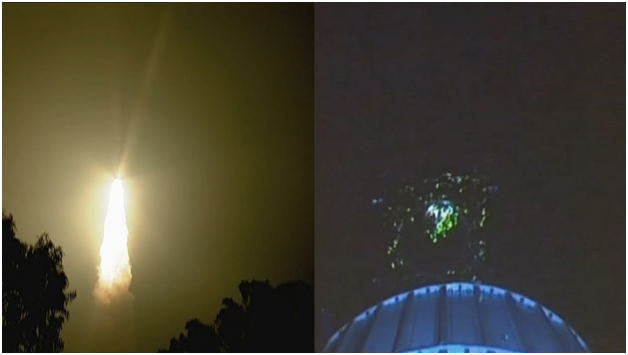
Microsat R has been developed by Defence Research and Development Organisation (DRDO) laboratories.
ISRO also used this launch as an opportunity to demonstrate the usability of the fourth stage of the rocket after the satellites are ejected into orbit.
Before this, the fourth stage used to just become yet another piece of space debris. However, ISRO has found a way to make use of this stage with student satellite Kalamsat, made by Space Kidz India, weighing just 1.26kg, attached to it.
The launch is PSLV’s 46th flight and the first flight with a new variant of PSLV called PSLV-DL with two strap-ons, each carrying 12.2-tonne of solid propellent.
At about 100 minutes after the lift-off, the rocket’s fourth stage was switched on again for few seconds before it was again cut off. Finally, at about 103 minutes after the rocket left the earth, the fourth stage – PS4 – began its role as an orbital platform carrying Kalamsat at an altitude of 450 km.[/vc_column_text][/vc_column][/vc_row][vc_row][vc_column][vc_column_text]
KALAMSAT
The fourth stage of the rocket with co-passenger Kalamsat, a students’ payload, is placed at a higher circular orbit, around 450 kms from earth, so as to establish an orbital platform for carrying out experiments.
Not a single rupee is being charged by the Indian Space Research Organisation (ISRO) for the task. The satellite designed and built by students who work with a private organization called “Space Kidz India” in Chennai weighs less than a wooden chair at only 1.26 kg.
The satellite was made at an expense of Rs 12 lakh and was made ready in six days, though the group perfected the technology over a span of six years, said Srimathy Kesan, a 45-year-old professional who steered this motley group of 20-somethings at Space Kidz India.
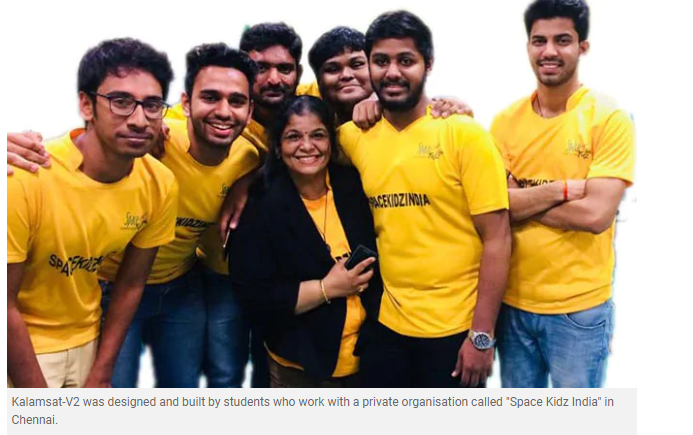
The Kalamsat-V2 is the lightest satellite in the world, the ISRO said, adding Thursday’s launch from the Satish Dhawan Space Centre in Sriharikota also marks another milestone – it’s the first satellite designed and built by an Indian private entity and Space Kidz India to be launched by ISRO.
[/vc_column_text][/vc_column][/vc_row][vc_row][vc_column][vc_raw_html]JTNDYmxvY2txdW90ZSUyMGNsYXNzJTNEJTIydHdpdHRlci10d2VldCUyMiUyMGRhdGEtbGFuZyUzRCUyMmVuJTIyJTNFJTNDcCUyMGxhbmclM0QlMjJlbiUyMiUyMGRpciUzRCUyMmx0ciUyMiUzRSVGMCU5RiU4NyVBRSVGMCU5RiU4NyVCMyUyMCUzQ2ElMjBocmVmJTNEJTIyaHR0cHMlM0ElMkYlMkZ0d2l0dGVyLmNvbSUyRmhhc2h0YWclMkZJU1JPTWlzc2lvbnMlM0ZzcmMlM0RoYXNoJTI2YW1wJTNCcmVmX3NyYyUzRHR3c3JjJTI1NUV0ZnclMjIlM0UlMjNJU1JPTWlzc2lvbnMlM0MlMkZhJTNFJTIwJTIwJTNDYSUyMGhyZWYlM0QlMjJodHRwcyUzQSUyRiUyRnR3aXR0ZXIuY29tJTJGaGFzaHRhZyUyRlBTTFZDNDQlM0ZzcmMlM0RoYXNoJTI2YW1wJTNCcmVmX3NyYyUzRHR3c3JjJTI1NUV0ZnclMjIlM0UlMjNQU0xWQzQ0JTNDJTJGYSUzRSUyMHN1Y2Nlc3NmdWxseSUyMHBsYWNlcyUyMCUzQ2ElMjBocmVmJTNEJTIyaHR0cHMlM0ElMkYlMkZ0d2l0dGVyLmNvbSUyRmhhc2h0YWclMkZNaWNyb3NhdFIlM0ZzcmMlM0RoYXNoJTI2YW1wJTNCcmVmX3NyYyUzRHR3c3JjJTI1NUV0ZnclMjIlM0UlMjNNaWNyb3NhdFIlM0MlMkZhJTNFJTIwaW50byUyMGl0cyUyMGludGVuZGVkJTIwb3JiaXQuJTIwJTNDYSUyMGhyZWYlM0QlMjJodHRwcyUzQSUyRiUyRnR3aXR0ZXIuY29tJTJGaGFzaHRhZyUyRkthbGFtc2F0JTNGc3JjJTNEaGFzaCUyNmFtcCUzQnJlZl9zcmMlM0R0d3NyYyUyNTVFdGZ3JTIyJTNFJTIzS2FsYW1zYXQlM0MlMkZhJTNFJTIwJTNDYSUyMGhyZWYlM0QlMjJodHRwcyUzQSUyRiUyRnQuY28lMkZoVklzS3pwbHBDJTIyJTNFcGljLnR3aXR0ZXIuY29tJTJGaFZJc0t6cGxwQyUzQyUyRmElM0UlM0MlMkZwJTNFJTI2bWRhc2glM0IlMjBJU1JPJTIwJTI4JTQwaXNybyUyOSUyMCUzQ2ElMjBocmVmJTNEJTIyaHR0cHMlM0ElMkYlMkZ0d2l0dGVyLmNvbSUyRmlzcm8lMkZzdGF0dXMlMkYxMDg4NTAzMDU3MzI1ODAxNDczJTNGcmVmX3NyYyUzRHR3c3JjJTI1NUV0ZnclMjIlM0VKYW51YXJ5JTIwMjQlMkMlMjAyMDE5JTNDJTJGYSUzRSUzQyUyRmJsb2NrcXVvdGUlM0UlMEElM0NzY3JpcHQlMjBhc3luYyUyMHNyYyUzRCUyMmh0dHBzJTNBJTJGJTJGcGxhdGZvcm0udHdpdHRlci5jb20lMkZ3aWRnZXRzLmpzJTIyJTIwY2hhcnNldCUzRCUyMnV0Zi04JTIyJTNFJTNDJTJGc2NyaXB0JTNFJTBB[/vc_raw_html][/vc_column][/vc_row][vc_row][vc_column][vc_column_text]
A 64-gram earlier version of the Kalamsat nicknamed “gulab jamun” because of its puny size was launched by the National Aeronautics and Space Administration (NASA) in 2017. But it never reached orbit.
PS4 is the smallest of the stages in size with a height of 2.5m and a diameter of 1.34m carrying 1.6 tonne propellent. With two liquid engines applying a thrust of 7.6kN each, PS4 is responsible for the correct injection of the payloads into their respective desired orbits.
According to Isro officials, PS4 will stay ‘alive’ for the next six months before it drifts away and disintegrates upon reaching the earth’s atmosphere. In the meantime, the cubesat made of space grade aluminium will be tested for its communication module, onboard computer, solar panels and electronics designed and developed by Indian students. The data from the tiny satellite will be collected by ground stations.
Congratulating the team for the successful mission, Isro chairman K Sivan said this was the first that PSLV was “flown to the lowest orbit.”
Sivan congratulated the students who designed Kalamsat and said, “For the first time the PS4 will be revived for students to do experiments.”
Prime Minister Narendra Modi also tweeted a congratulation to the scientists behind the successful launch.
The PSLV, basically a four-stage vehicle with alternating solid and liquid stages, has launched 54 Indian and 269 satellites of international customers.[/vc_column_text][/vc_column][/vc_row]
India News
President Droupadi Murmu launches India’s first homegrown CAR T-cell therapy for cancer treatment
The gene-based therapy, which is developed by the IIT Bombay and Tata Memorial Centre, is being rolled out in India at about one-tenth of its price outside the country.
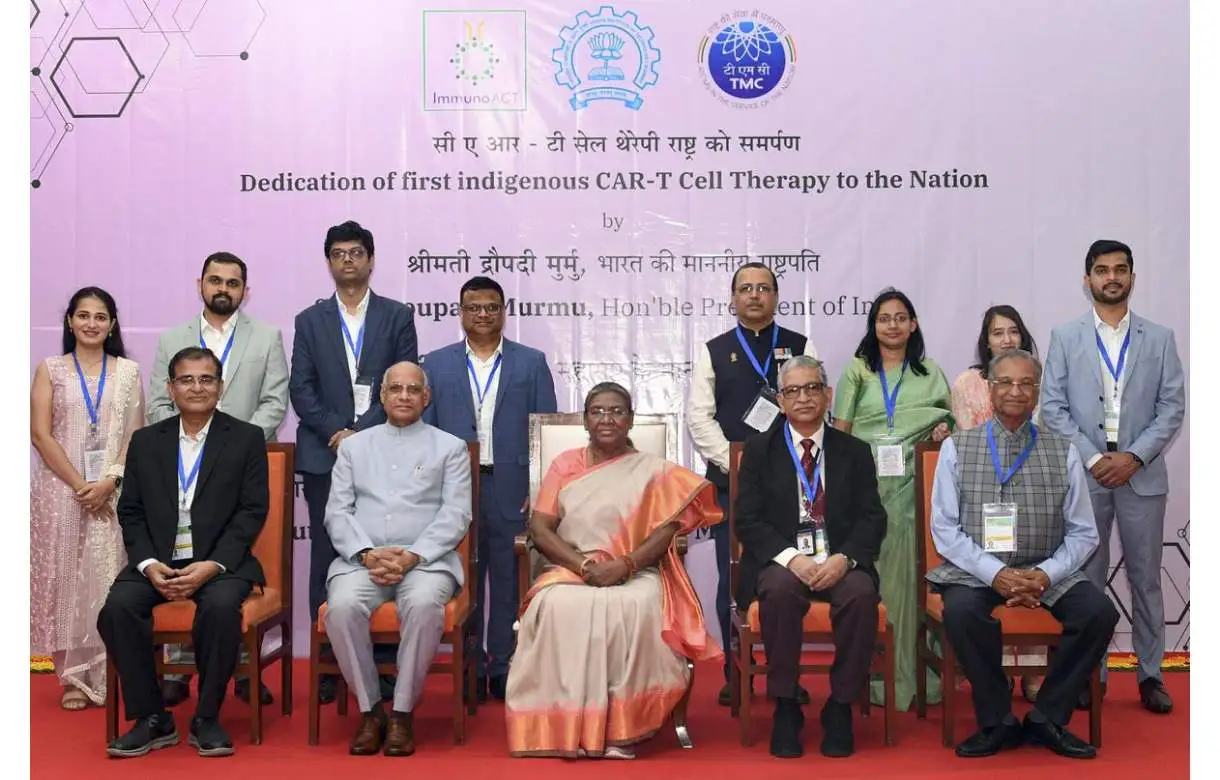
President Droupadi Murmu on Thursday launched India’s first indigenously-developed CAR T-cell therapy, a gene-based therapy, for cancer treatment, hailing it as a breakthrough that provides new hope for humankind in the battle against the diseases.
Speaking at the launch event at the Indian Institute of Technology (IIT) Bombay, Murmu said the indigenous development of the CAR T-cell therapy was an example of the Make in India initiative.
The gene-based therapy, which is developed by the IIT Bombay and Tata Memorial Centre, is being rolled out in India at about one-tenth of its price outside the country, as per the senior official.
In CAR T-cell therapy, a patient’s T-cells, which is a type of immune system cell or stem cell, are modified in the laboratory and inserted back into the patient to attack and destroy cancer cells after editing the stem cell.
The NexCAR19 CAR T-cell therapy, the country’s first Made in India CAR T-cell therapy, is expected to bring down the cost of treatment significantly.
During her speech, Murmu said that this therapy is considered a phenomenal advance in medical sciences. The development of this therapy is also an example of the Make in India initiative and speaks volumes about Indian scientists and physicians, she added.
The launch of India’s first gene therapy is a significant breakthrough in the battle against cancer. As this line of treatment, named CAR T-cell therapy, is accessible and affordable, it provides a new hope for the whole of humankind, President Murmu further added.
The Tata Memorial Centre director Sudeep Gupta said the CAR T-cell therapy was enormously expensive and out of the reach of an overwhelming majority of people.
Asserting that, he said NexCar19 needs to be custom manufactured for every patient under the most stringent conditions, but it has been rolled out at approximately one-tenth of the price at which it is available outside India.
The treatment costs approximately Rs 4 crore abroad against Rs 30 lakh in India, said IIT Bombay director Prof Subhasis Chaudhuri.
He further said that the low-cost CAR T-cell therapy was a huge achievement for the country and cancer patients, and places India firmly on the global map of cell and gene therapy.
Comparing the achievement of Chandrayaan-3 with CAR T-cell therapy, Chaudhuri asserted that CAR-T cell therapy heralds India’s entry into the cell and genetic engineering group.
The Tata Memorial Centre director Gupta said the treatment will help some 20,000 Indians every year, and its rollout is a milestone in the field of cancer care and genetic engineering.
He added the CAR T-cell was not only a scientific achievement of the highest order but also had immense practical application. NexCAR19 will save many, many lives and wipe many, many tears, he emphasised.
India News
ISRO launches weather satellite INSAT-3DS to monitor Earth’s surface, oceans
The Naughty Boy has now become a mature, obedient and disciplined boy like PSLV, and GSLV as they have become a very robust vehicle for ISRO, said Tomy Joseph.
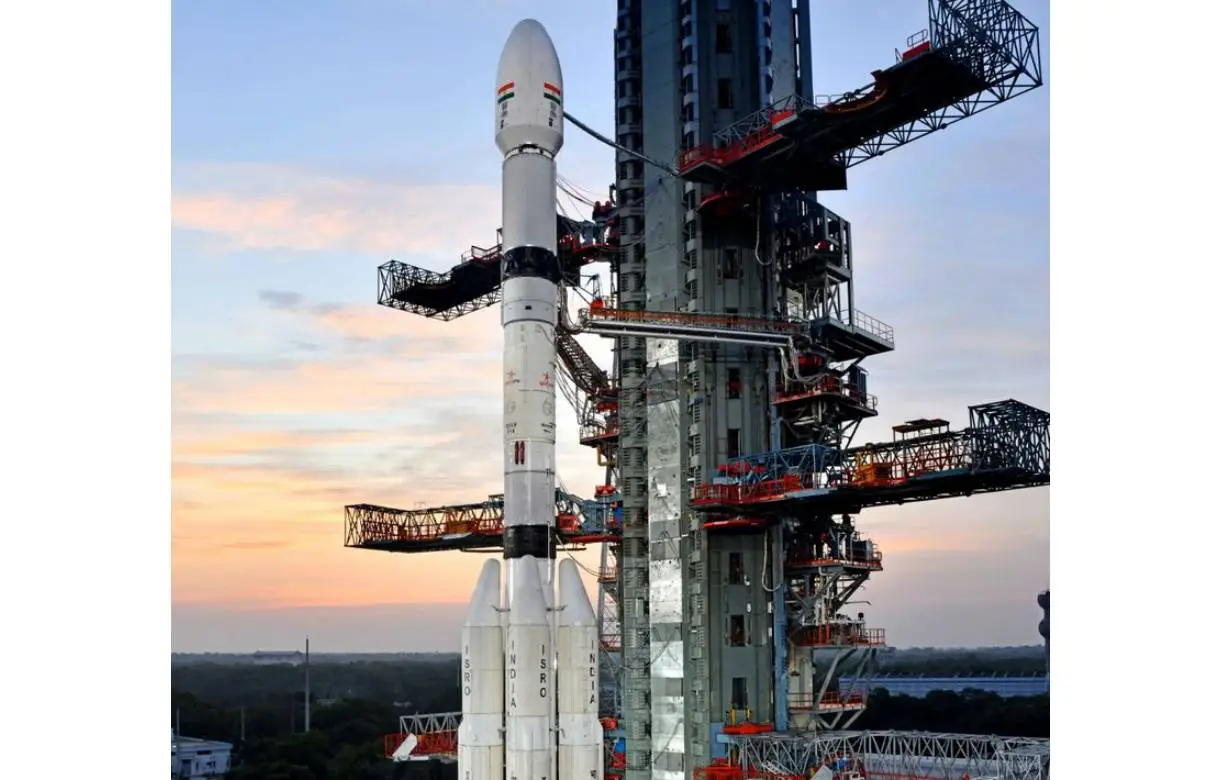
The Indian Space Research Organisation (ISRO) on Saturday launched the INSAT-3DS mission from Satish Dhawan Space Centre in Sriharikota at 5:35 pm to monitor the Earth’s surface, observe the ocean and analyse the environment through various essential meteorological perspectives.
In its mission, the Geosynchronous Satellite Launch Vehicle (GSLV) aimed to deploy the INSAT-3DS meteorological satellite into the Geosynchronous Transfer Orbit (GTO). Subsequent orbit-raising maneuvers will ensure that the satellite is positioned in a Geo-stationary Orbit.
After being positioned in GSO, it will provide information on diverse atmospheric conditions via vertical profiles. INSAT-3DS will manage data collection and dissemination from Data Collection Platforms (DCPs). The satellite will help in search and rescue services.
Congratulating the team, ISRO Chairman S Somanath expressed his happiness over the successful accomplishment of the mission GSLV-F14 INSAT-3DS. He further said that the spacecraft has been injected into a very good orbit. The space agency has also noted that the vehicle has performed very well.
The INSAT-3DS Mission Director, Tomy Joseph sarcastically remarked, saying the Naughty Boy has now become a mature, obedient and disciplined boy like PSLV, and GSLV as they have become a very robust vehicle for ISRO.
The Geosynchronous Satellite Launch Vehicle (GSLV) is a launch vehicle with a length of 51.7 meters and a liftoff mass of 420 tonnes. It consists of three stages, the first stage (GS1) is made up of a solid propellant motor with 139-ton propellant and four earth-storable propellant stages (L40) strapons. Each strapon carries 40 tons of liquid propellant.
The second stage (GS2) is also an earth-storable propellant stage that carries 40-ton propellant, and the third stage (GS3) is a cryogenic stage with a 15-ton propellant loading of liquid oxygen (LOX) and liquid hydrogen (LH2).
To protect the satellite during the atmospheric regime, it is covered by an Ogive payload fairing. The GSLV is versatile and can be used to launch various spacecraft capable of performing communications, navigation, earth resource surveys, and other proprietary missions.
The launch of INSAT-3DS was a follow-on mission of Third Generation Meteorological Satellite from Geostationary Orbit. According to ISRO, the GSLV-F14/INSAT-3DS mission has been fully funded by the Ministry of Earth Sciences (MoES) and designed for enhanced meteorological observations and monitoring of land and ocean surfaces for weather forecasting and disaster warning.
The satellite will augment the Meteorological services along with the presently operational INSAT-3D and INSAT-3DR satellites.
Notably, the services will be used by various departments of the MoES such as the India Meteorology Department (IMD), National Centre for Medium-Range Weather Forecasting (NCMRWF), Indian Institute of Tropical Meteorology (IITM), National Institute of Ocean Technology (NIOT), Indian National Center for Ocean Information Services (INCOIS) and various other agencies.
India News
PM Modi says day not far when an Indian will land on moon in indigenously built spacecraft
PM Modi said a strong roadmap has been drawn till 2040 for the space sector. He made the announcement after flagging off the first Namo Bharat train on the 17 km stretch of the Delhi-Meerut Regional Rapid Transit system.

Prime minister Narendra Modi on Friday said the government has drawn up a roadmap for the development of space sector and the day is not far when an Indian will travel to the moon in an indigenously built spacecraft. PM Modi said India’s Gaganyaan will soon take Indian astronauts to space and the India wants to establish its own space station.
PM Modi said a strong roadmap has been drawn till 2040 for the space sector. He made the announcement after flagging off the first Namo Bharat train on the 17 km stretch of the Delhi-Meerut Regional Rapid Transit system.
PM Modi recalled the success of India’s moon mission Chandrayaan3 which had recently placed the country’s tricolour on the lunar surface. He said India of the 21st century is writing new chapters of progress and development for the landing on the moon has left the world awestruck.
PM Modi added with impeccable hosting of the G20 summit, today’s India has become the centre of attraction and curiosity for the world. He said today’s India wins more than 100 medals in the Asian Games.
PM Modi added today’s India launches 5G on its own strength and takes it to all corners of India. He further added todays India does the highest number of digital transactions. He said the Namo trains that were flagged off today were all made in India.
PM Modi set goals for the Indian Space Research Organisation (ISRO) by asking engineers and scientists to work towards setting up an Indian space staion by 2035 and sending an Indian astronaut to the lunar surface by 2040. PM Modi also asked the scientists to undertake interplanetary missions like the Venus orbiter and also attempt a landing on Mars. PM Modi further added the government has handed over festival gifts by reducing the gas cylinder price by Rs 500 for Ujjwala Yojana beneficiaries.
-
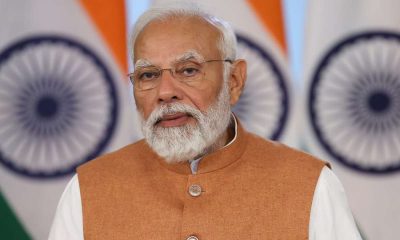
 2024 Lok Sabha Elections19 hours ago
2024 Lok Sabha Elections19 hours agoPM Modi calls for high voter turnout in second phase of Lok Sabha elections 2024, says your vote is your voice
-

 2024 Lok Sabha Elections13 hours ago
2024 Lok Sabha Elections13 hours agoLok Sabha election 2024: Nearly 50% voter turnout recorded in second phase till 3 pm
-

 India News17 hours ago
India News17 hours agoSalman Khan house firing case: NIA interrogates arrested shooters Sagar Pal, Vicky Gupta for three hours
-

 2024 Lok Sabha Elections11 hours ago
2024 Lok Sabha Elections11 hours agoElection Commission books BJP MP Tejasvi Surya for seeking votes in the name of religion
-
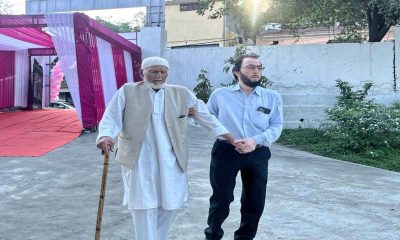
 2024 Lok Sabha Elections16 hours ago
2024 Lok Sabha Elections16 hours agoLok Sabha elections 2024: 102-year-old man walks to polling booth to cast his vote in Jammu









